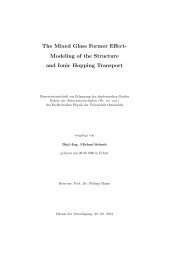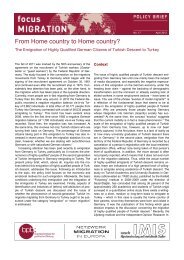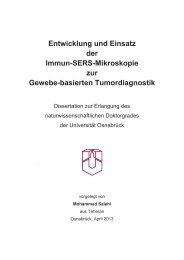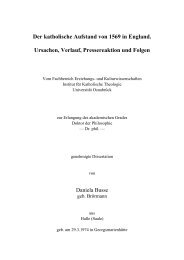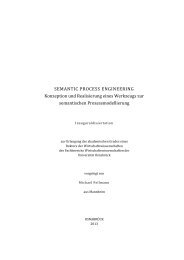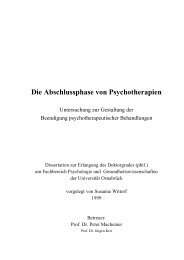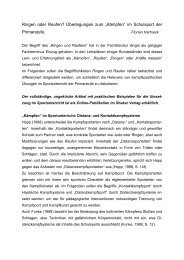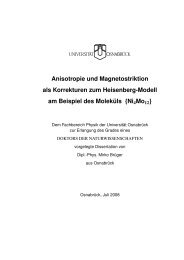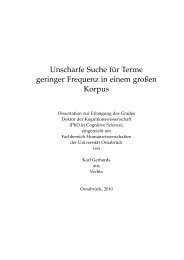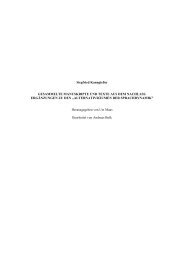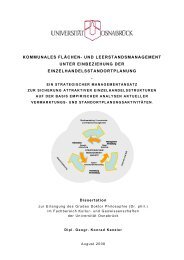- Seite 1 und 2: Krankheitseinsicht, dynamisch getes
- Seite 3 und 4: Danksagung iii Einleitung Es wird Z
- Seite 5 und 6: v Einleitung 5.2.3.5 Prozessorienti
- Seite 7 und 8: vii Einleitung 12.1.3 Ergebnisse St
- Seite 9 und 10: ix Einleitung Tabelle 45. Hauptkomp
- Seite 11: Tabelle 1. Verzeichnis der wichtigs
- Seite 15 und 16: 15 Einleitung Angesichts der Belieb
- Seite 17 und 18: 17 Einleitung Bewältigungsmodell v
- Seite 19 und 20: 19 Wisconsin Card Sorting Test 2001
- Seite 21 und 22: 21 Wisconsin Card Sorting Test Effe
- Seite 23 und 24: 23 Wisconsin Card Sorting Test Das
- Seite 25 und 26: Tabelle 2. Exekutive und Arbeitsged
- Seite 27 und 28: 3.3 Durchführung und Kennwerte des
- Seite 29 und 30: 3.4 WCST-Defizite bei Schizophrenie
- Seite 31 und 32: Tabelle 5. Konzeptuelles Schema zur
- Seite 33 und 34: 3.5.1 Attributidentifikation / Abst
- Seite 35 und 36: 35 Wisconsin Card Sorting Test oder
- Seite 37 und 38: 37 Wisconsin Card Sorting Test elem
- Seite 39 und 40: 39 Wisconsin Card Sorting Test ein
- Seite 41 und 42: 41 Wisconsin Card Sorting Test Fehl
- Seite 43 und 44: 43 Wisconsin Card Sorting Test zus
- Seite 45 und 46: 45 Wisconsin Card Sorting Test Lern
- Seite 47 und 48: 3.5.5 Orientierungsvariablen 47 Wis
- Seite 49 und 50: 49 Wisconsin Card Sorting Test zehn
- Seite 51 und 52: 51 Wisconsin Card Sorting Test Fehl
- Seite 53 und 54: 53 Wisconsin Card Sorting Test mit
- Seite 55 und 56: 55 Wisconsin Card Sorting Test PAOL
- Seite 57 und 58: Tabelle 6. Übersicht über Studien
- Seite 59 und 60: 3.7.3 Faktorstruktur des WCST 59 Wi
- Seite 61 und 62: Tabelle 7 (Fortsetzung). (o) (p) (q
- Seite 63 und 64:
3.8.2 Bildung 63 Wisconsin Card Sor
- Seite 65 und 66:
3.9 Der Dynamische WCST in der Schi
- Seite 67 und 68:
67 Wisconsin Card Sorting Test darg
- Seite 69 und 70:
69 Wisconsin Card Sorting Test WIED
- Seite 71 und 72:
71 Wisconsin Card Sorting Test Durc
- Seite 73 und 74:
73 Wisconsin Card Sorting Test 3.9.
- Seite 75 und 76:
75 Wisconsin Card Sorting Test WALL
- Seite 77 und 78:
4. Statistische Modelle der Veränd
- Seite 79 und 80:
79 Reliable Change Index mittleren
- Seite 81 und 82:
81 Reliable Change Index (b) x2 sol
- Seite 83 und 84:
83 Reliable Change Index (3.) regre
- Seite 85 und 86:
85 Reliable Change Index Bei einem
- Seite 87 und 88:
87 Reliable Change Index statistisc
- Seite 89 und 90:
89 Reliable Change Index der Differ
- Seite 91 und 92:
91 Reliable Change Index Patienten
- Seite 93 und 94:
93 Reliable Change Index Tabelle 8.
- Seite 95 und 96:
95 Reliable Change Index WIEDL, WIE
- Seite 97 und 98:
97 Coping und Abwehr (3.) die oftma
- Seite 99 und 100:
Darstellung der wichtigsten tiefenp
- Seite 101 und 102:
101 Coping und Abwehr unterschiedli
- Seite 103 und 104:
103 Coping und Abwehr von Bewältig
- Seite 105 und 106:
105 Coping und Abwehr bedrohliche K
- Seite 107 und 108:
107 Coping und Abwehr das Problem d
- Seite 109 und 110:
5.2.3.6 Antezedenzien von Bewertung
- Seite 111 und 112:
6. Krankheitseinsicht von Menschen
- Seite 113 und 114:
113 Krankheitseinsicht die Bedeutun
- Seite 115 und 116:
115 Krankheitseinsicht Kombination
- Seite 117 und 118:
117 Krankheitseinsicht negative Bew
- Seite 119 und 120:
119 Krankheitseinsicht Während die
- Seite 121 und 122:
121 Krankheitseinsicht WARNER, TAYL
- Seite 123 und 124:
123 Krankheitseinsicht Symptomatik
- Seite 125 und 126:
125 Krankheitseinsicht (z. B. aus d
- Seite 127 und 128:
127 Krankheitseinsicht Diesem Zweck
- Seite 129 und 130:
6.5.2 Krankheitseinsicht: Begriffsk
- Seite 131 und 132:
131 Krankheitseinsicht Der erste be
- Seite 133 und 134:
Tabelle 11. Konfigurationen von Ein
- Seite 135 und 136:
6.5.4.1 Einsichts-Interviews 135 Kr
- Seite 137 und 138:
137 Krankheitseinsicht having sympt
- Seite 139 und 140:
139 Krankheitseinsicht Self-Apprais
- Seite 141 und 142:
141 Krankheitseinsicht chronifizier
- Seite 143 und 144:
143 Krankheitseinsicht have a menta
- Seite 145 und 146:
145 Krankheitseinsicht veröffentli
- Seite 147 und 148:
147 Krankheitseinsicht werden als r
- Seite 149 und 150:
149 Krankheitseinsicht Wichtig wär
- Seite 151 und 152:
151 Krankheitseinsicht Die Befundla
- Seite 153 und 154:
Pfad b Interaktionale Konstruktion
- Seite 155 und 156:
155 Krankheitseinsicht Validierung
- Seite 157 und 158:
6.5.12 Die nosologische Hypothese:
- Seite 159 und 160:
159 Krankheitseinsicht Die Möglich
- Seite 161 und 162:
161 Krankheitseinsicht Exekutivfunk
- Seite 163 und 164:
163 Krankheitseinsicht (z. B. HILL,
- Seite 165 und 166:
165 Krankheitseinsicht Einige Autor
- Seite 167 und 168:
167 Krankheitseinsicht Fehlattribut
- Seite 169 und 170:
6.5.14 Motivationale Hypothesen: Ab
- Seite 171 und 172:
171 Krankheitseinsicht Das RS-Konze
- Seite 173 und 174:
173 Krankheitseinsicht problemzentr
- Seite 175 und 176:
175 Krankheitseinsicht ursprünglic
- Seite 177 und 178:
177 Krankheitseinsicht reduzierter
- Seite 179 und 180:
179 Krankheitseinsicht äußerst kn
- Seite 181 und 182:
Prämorbide Intelligenz Psychose- E
- Seite 183 und 184:
183 Krankheitseinsicht personen, al
- Seite 185 und 186:
6.5.16 Multifaktorielle Einsichts-M
- Seite 187 und 188:
187 Krankheitseinsicht Erkrankungsb
- Seite 189 und 190:
7. Fragestellungen und Hypothesen 1
- Seite 191 und 192:
Hypothese 2.4: Validierung anhand d
- Seite 193 und 194:
Hypothese 3.3: Einsicht und Exekuti
- Seite 195 und 196:
8. Methoden 8.1 Beschreibung der In
- Seite 197 und 198:
197 Methoden Select-by-marker-Analy
- Seite 199 und 200:
199 Methoden eine weitere, eher all
- Seite 201 und 202:
201 Methoden Obwohl ursprünglich l
- Seite 203 und 204:
203 Methoden Tabelle 15 stellt den
- Seite 205 und 206:
205 Ergebnisse Studie 1 Hälfte auc
- Seite 207 und 208:
207 Ergebnisse Studie 1 Tabelle 18.
- Seite 209 und 210:
9.4 Hauptkomponentenanalyse des WCS
- Seite 211 und 212:
10. Ergebnisse Studie 2: 211 Ergebn
- Seite 213 und 214:
213 Ergebnisse Studie 2 postakuten
- Seite 215 und 216:
215 Ergebnisse Studie 2 entspricht
- Seite 217 und 218:
217 Ergebnisse Studie 2 Verteilung
- Seite 219 und 220:
Tabelle 24. Übersicht über berech
- Seite 221 und 222:
Tabelle 26. Zehn WCST-Performanztyp
- Seite 223 und 224:
223 Ergebnisse Studie 2 Zusammenhan
- Seite 225 und 226:
10.6 Unterschiedstests und Konkorda
- Seite 227 und 228:
227 Ergebnisse Studie 2 nach LANDIS
- Seite 229 und 230:
229 Ergebnisse Studie 2 zur Decke,
- Seite 231 und 232:
10.8 Komposition von Metatypen 231
- Seite 233 und 234:
Tabelle 35. Cluster-Varianzen und F
- Seite 235 und 236:
10.8.2 Übereinstimmung von RCI-Typ
- Seite 237 und 238:
Tabelle 39. Kreuztabelle WCSTdyn-Cl
- Seite 239 und 240:
239 Ergebnisse Studie 2 Die dargest
- Seite 241 und 242:
Tabelle 42. Korrekte Sortierungen i
- Seite 243 und 244:
10.9 Soziodemographische und klinis
- Seite 245 und 246:
Tabelle 45. Rotierte Komponentenmat
- Seite 247 und 248:
10.10 Externe Validierung der Metat
- Seite 249 und 250:
249 Ergebnisse Studie 2 Es besteht
- Seite 251 und 252:
Tabelle 51. Lernverläufe der AVLT-
- Seite 253 und 254:
253 Ergebnisse Studie 2 10.10.3 Faz
- Seite 255 und 256:
255 Ergebnisse Studie 2 Angesichts
- Seite 257 und 258:
10.12 Analyse von WCST-Fehlerprofil
- Seite 259 und 260:
259 Ergebnisse Studie 2 ausschließ
- Seite 261 und 262:
261 Ergebnisse Studie 2 Die Fehler-
- Seite 263 und 264:
263 Ergebnisse Studie 3 den Zusamme
- Seite 265 und 266:
265 Ergebnisse Studie 3 übrigen It
- Seite 267 und 268:
267 Ergebnisse Studie 3 Partialkorr
- Seite 269 und 270:
Tabelle 66. Symptombewusstheit, Pos
- Seite 271 und 272:
271 Ergebnisse Studie 3 11.6 Konver
- Seite 273 und 274:
11.8 Aktive und passive Medikations
- Seite 275 und 276:
11.10 Einsicht, Exekutivfunktionen
- Seite 277 und 278:
277 Ergebnisse Studie 3 Offenheit k
- Seite 279 und 280:
279 Ergebnisse Studie 3 52 Patiente
- Seite 281 und 282:
281 Ergebnisse Studie 3 wies einen
- Seite 283 und 284:
283 Ergebnisse Studie 3 Insgesamt k
- Seite 285 und 286:
285 Ergebnisse Studie 3 Das gleiche
- Seite 287 und 288:
287 Ergebnisse Studie 3 G12 = 3,5 (
- Seite 289 und 290:
Tabelle 81. Kognition und Symptomat
- Seite 291 und 292:
291 Ergebnisse Studie 3 Aufgrund de
- Seite 293 und 294:
293 Ergebnisse Studie 3 Es ist auff
- Seite 295 und 296:
295 Ergebnisse Studie 3 Im nächste
- Seite 297 und 298:
297 Ergebnisse Studie 3 kognitiv le
- Seite 299 und 300:
299 Diskussion An einer nicht-psych
- Seite 301 und 302:
Hypothese Gegenstand Ergebnis 2.1 S
- Seite 303 und 304:
3.5 Kurvilinearer Zusammenhang (qua
- Seite 305 und 306:
12.2.2 Diskussion Studie 2: RCI-Ver
- Seite 307 und 308:
307 Diskussion Insbesondere scheint
- Seite 309 und 310:
309 Diskussion »Metatypen« zu kl
- Seite 311 und 312:
311 Diskussion Fehlertypen: Währen
- Seite 313 und 314:
313 Diskussion Funktionsbereiche (s
- Seite 315 und 316:
12.2.3.1 Diskussion der OSSTI 315 D
- Seite 317 und 318:
12.2.3.2 Einsicht und Depressivitä
- Seite 319 und 320:
12.2.3.3 Einsicht und Exekutivfunkt
- Seite 321 und 322:
321 Diskussion Arbeitsgedächtnis (
- Seite 323 und 324:
323 Diskussion zur hirnorganisch ve
- Seite 325 und 326:
12.2.3.5 Überprüfung des Einsicht
- Seite 327 und 328:
327 Diskussion sozialer Konsequenze
- Seite 329 und 330:
329 Diskussion Diagnose zurückwies
- Seite 331 und 332:
12.3 Schlusswort 331 Diskussion Die
- Seite 333 und 334:
Literatur ACKERMANN, R. & DERUBEIS,
- Seite 335 und 336:
335 Literatur BAUMEISTER, R. F., DA
- Seite 337 und 338:
337 Literatur BURNS, J. W. (2000).
- Seite 339 und 340:
339 Literatur DABAN, C., AMADO, I.,
- Seite 341 und 342:
341 Literatur FERRERI, M., ROUILLON
- Seite 343 und 344:
343 Literatur GOLDMAN, R. S., AXELR
- Seite 345 und 346:
345 Literatur HAYGOOD, R. C. & BOUR
- Seite 347 und 348:
JANZARIK, W. (2003). Der Psychose-B
- Seite 349 und 350:
349 Literatur KOLB, B. & WHISHAW, I
- Seite 351 und 352:
351 Literatur LYSAKER, P. H. & BELL
- Seite 353 und 354:
353 Literatur MCGUIGAN, F. J. (1974
- Seite 355 und 356:
355 Literatur NIEUWENSTEIN, M. R.,
- Seite 357 und 358:
357 Literatur PINI, S., CASSANO, G.
- Seite 359 und 360:
359 Literatur SACKEIM, H. A. & GUR,
- Seite 361 und 362:
361 Literatur SMITH, T. E., HULL, J
- Seite 363 und 364:
363 Literatur TRANULIS, C., LEPAGE,
- Seite 365 und 366:
365 Literatur WEILER, M. A., FLEISH
- Seite 367 und 368:
367 Literatur YOUNG, D. A., ZAKZANI
- Seite 369 und 370:
Perseverative Fehler Prätest .161
- Seite 371 und 372:
C Einverständniserklärung 371 Anh
- Seite 373 und 374:
E Fragebogen zur Behandlungseinsch
- Seite 375 und 376:
F FKV-Instruktion »Trait« 375 Anh
- Seite 377 und 378:
Coping Strategies Task (CST): Auswe
- Seite 379:
379 Anhang Erklärung über die Eig



